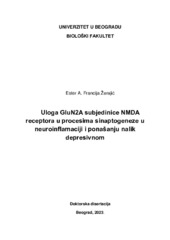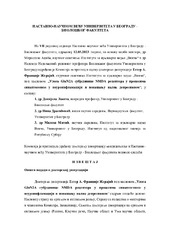Приказ основних података о дисертацији
Uloga GluN2A subjedinice NMDA receptora u procesima sinaptogeneze u neuroinflamaciji i ponašanju nalik depresivnom
The role of GluN2A subunit of NMDA receptor in synaptogenesis and depressive like behaviour in an animal model of neuroinflammation
| dc.contributor.advisor | Adžić, Miroslav | |
| dc.contributor.other | Nedeljković, Nadežda | |
| dc.contributor.other | Laketa, Danijela | |
| dc.contributor.other | Dragićević, Nina | |
| dc.contributor.other | Mitić, Miloš | |
| dc.creator | Francija Žerajić, Ester | |
| dc.date.accessioned | 2023-12-05T16:19:03Z | |
| dc.date.available | 2023-12-05T16:19:03Z | |
| dc.date.issued | 2023-09-29 | |
| dc.identifier.uri | https://uvidok.rcub.bg.ac.rs/doccall/bitstream/handle/123456789/5375/Referat.pdf | |
| dc.identifier.uri | https://eteze.bg.ac.rs/application/showtheses?thesesId=9387 | |
| dc.identifier.uri | https://fedorabg.bg.ac.rs/fedora/get/o:31874/bdef:Content/download | |
| dc.identifier.uri | https://plus.cobiss.net/cobiss/sr/sr/bib/131009289 | |
| dc.identifier.uri | https://nardus.mpn.gov.rs/handle/123456789/21947 | |
| dc.description.abstract | Inflamatorni medijatori imaju značajnu ulogu u patofiziologiji depresije. U centralnom nervnom sistemu, citokini, između ostalog, mogu da naruše neuroplastičnost i balans unutar neurotransmiterskih sistema. Neuroinflamacija može da izazove produkciju neuroaktivnih metabolita (hinolinska kiselina) koji interferiraju sa aktivnošću N-metil-D-aspartatnih (NMDA) receptora i tako dovode do promena u glutamatnoj neurotransmisiji, što za posledicu može imati razvoj depresivnih simptoma. Sa druge strane, pokazano je da antidepresivni efekti neselektivnih antagonista NMDA receptora zavise od aktivacije mTOR signalnog puta koji podstiče lokalnu translaciju sinaptičkih proteina u dendritima i tako promoviše sinaptogenezu. Dakle, ovi podaci nedvosmisleno govore o ulozi NMDA receptora u patofiziologiji depresije, međutim, o ulozi specifičnih subjedinica NMDA receptora i njihovom doprinosu patologiji depresije se ne zna dovoljno, a upravo bi ova saznanja mogla doprineti efikasnijoj antidepresivnoj terapiji. U svetlu navedenih literaturnih podataka u ovoj doktorskoj disertaciji ispitivana je specifična uloga GluN2A subjedinice NMDA receptora u nastanku ponašanja nalik depresivnom kod C57BL/6J miševa, u neuroinflamatornom modelu depresije. Takođe, u sinaptozomima hipokampusa i prefrontalnog korteksa (PFC) ispitivani su molekularni signali koji se mogu nalaziti u osnovi depresivnog fenotipa kod životinja, sa posebnim osvrtom na mTOR signalni put i sinaptogenezu kao i procese neuroplastičnosti. Rezultati ove doktorske disertacije su pokazali da miševi sa trajno utišanom ekspresijom gena za GluN2A subjedinicu NMDA receptora (GluN2A-/-) ne ispoljavaju ponašanje nalik depresivnom u neuroinflamatornom modelu depresije, suprotno životinjama divljeg soja (WT) tretiranih lipopolisaharidom (LPS)... | sr |
| dc.description.abstract | Inflammatory mediators play a significant role in the pathophysiology of depression. Within the brain, cytokines, among other things, can affect the neuroplasticity and neurotransmitter systems. Namely, neuroinflammation can induce the production of neuroactive metabolites (quinolinic acid) that interfere with N-methyl-D-aspartate receptor (NMDAR)-mediated glutamate neurotransmission and lead to depressive-like behavior. On the other hand, it has been shown that the antidepressant effects of nonselective NMDAR antagonists depend on the activation of mammalian target of rapamycin (mTOR) signaling pathway, which stimulates local translation of synaptic proteins in dendrites and thus promotes synaptogenesis. Therefore, the activation of NMDAR with quinolinic acid, associated with the development of depressive-like behavior in neuroinflammatory conditions, as well as the antidepressant properties of NMDAR antagonists unequivocally indicate the involvement of this receptor in the pathophysiology of depression. However, not enough is known about the role of specific NMDAR subunits and their contribution to the pathology of depression, knowledge of which could contribute to more effective antidepressant therapy. In light of these studies, we examined the specific role of the GluN2A subunit of NMDAR in the development of depressive-like behavior in C57BL/6J mice, in the neuroinflammation-induced model of depression. We also investigated the mechanisms underlying the observed behavioral changes, with emphasis on the activity of mTOR signaling pathway, synaptogenesis and neuroplasticity processes in the synaptosomes of hippocampus and prefrontal cortex (PFC). The results of this doctoral dissertation showed that GluN2A-/- mice do not exhibit depressive-like behavior after immune challenge, in contrast to wild-type (WT) animals treated with Lypopilisaccharide (LPS)... | en |
| dc.format | application/pdf | |
| dc.language | sr | |
| dc.publisher | Универзитет у Београду, Биолошки факултет | sr |
| dc.rights | openAccess | en |
| dc.rights.uri | https://creativecommons.org/licenses/by-nc-nd/4.0/ | |
| dc.source | Универзитет у Београду | sr |
| dc.subject | lipopolisaharid, ponašanje nalik depresivnom, GluN2A-/-, mTOR signalni put, sinaptogeneza, neuroplastičnost, miš, prefrontalni korteks, hipokampus | sr |
| dc.subject | lipopolysaccharide, depressive-like behavior, GluN2A-/-, mTOR signaling pathway, synaptogenesis, neuroplasticity, mice, prefrontal cortex, hippocampus | en |
| dc.title | Uloga GluN2A subjedinice NMDA receptora u procesima sinaptogeneze u neuroinflamaciji i ponašanju nalik depresivnom | sr |
| dc.title.alternative | The role of GluN2A subunit of NMDA receptor in synaptogenesis and depressive like behaviour in an animal model of neuroinflammation | en |
| dc.type | doctoralThesis | |
| dc.rights.license | BY-NC-ND | |
| dc.identifier.fulltext | http://nardus.mpn.gov.rs/bitstream/id/157524/Disertacija_14492.pdf | |
| dc.identifier.fulltext | http://nardus.mpn.gov.rs/bitstream/id/157525/Izvestaj_Komisije_14492.pdf | |
| dc.identifier.rcub | https://hdl.handle.net/21.15107/rcub_nardus_21947 |



